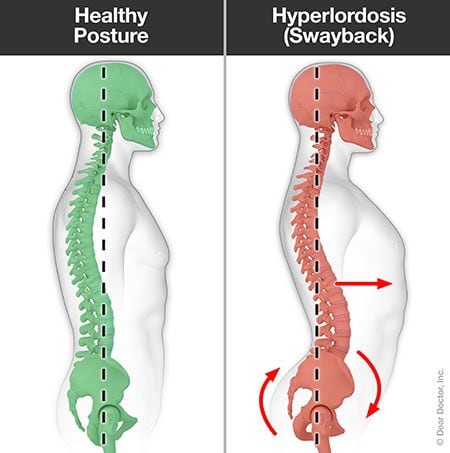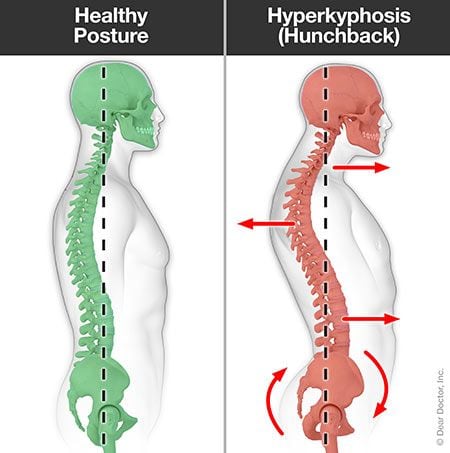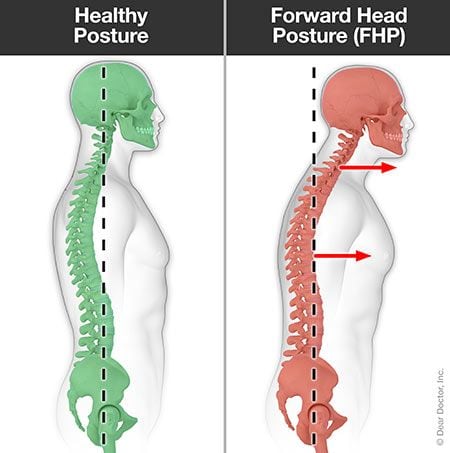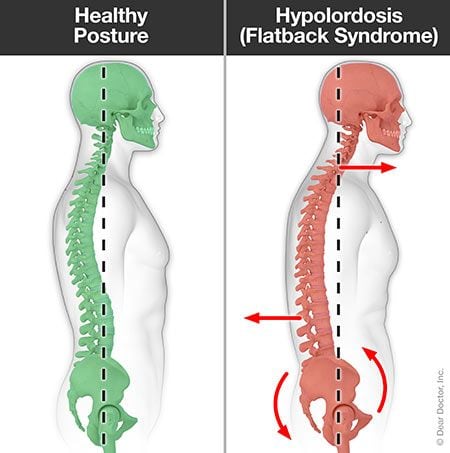Good posture makes you look taller and more confident, but it does a lot more than that. The spine has a natural S-shaped curve that absorbs shock and distributes the load from our body weight so it can handle the stress of movement.
A healthy, stable spine is that base that allows your body to do all the things it needs to do. A weak or unstable spine can result in pain, loss of function and often injury. Here’s a look at common posture problems, how they affect you, and what chiropractic care can do for them.
Hyperlordosis (Swayback)

Hyperlordosis, commonly known as “swayback,” is an exaggerated inward curve of the spine. It usually occurs in the lumbar (lower) spine, but it can also develop in the cervical spine (neck).
Certain diseases or disorders can cause swayback, but it’s often the result of poor posture. Hyperlordosis shifts our weight distribution, increasing stress on muscles and ligaments—and that makes them more vulnerable to injury as well as added wear and tear. Over time, swayback can lead to a forward pelvic tilt, muscle spasms, stiffness, tightening and low back or neck pain.
A chiropractor can suggest therapies to help restore normal curvature, improve posture, slow the degenerative process and reduce pain and inflammation. Chiropractic rehabilitation for hyperlordosis includes a variety of holistic techniques such as specific stretches and strengthening exercises to address muscle imbalance and maintain healthy spinal curves.
Hyperkyphosis (Hunchback)

Hyperkyphosis, also known as a “hunchback,” is an abnormal curve of the thoracic spine (middle back) of more than 40 degrees. It can make your back hurt, impair mobility and increase the risk for falls and fractures. Hyperkyphosis can be linked secondarily to disease or congenital problems, but most often it’s the result of poor posture and weak muscles and ligaments that surround the spine.
If posture is at the root of the problem, a chiropractor can show you how to sit, stand and lie down to help correct the condition. Other treatments may include periodic spinal manipulations, gentle stretching, exercise recommendations, mild electrical stimulation, ultrasound and trigger-point therapy that loosens knotted, painful muscles. Treatment is focused on reducing inflammation and pain, decreasing muscle spasms, improving spinal mobility and soft tissue strength, and slowing degeneration.
Hyperkyphosis tends to worsen over time and can contribute to and create secondary problems such as neck pain and headaches. It can affect your overall quality of life, so it’s important to seek chiropractic care for this condition.
Forward Head Posture (FHP)

Forward Head Posture (FHP) can develop in response to hyperkyphosis. When your shoulders and upper back are rounded forward, it brings your head down and forward, so you lose the natural curve of your neck. This causes much of the weight of the head originally supported by the spine to transfer to neck and shoulder muscles as you hold your head in a position that defies gravity. The farther forward you lean, the more your head seems to weigh.
The result? Instead of supporting the typical weight of your head (about 12 pounds), you are now supporting an effective weight of over 50 pounds, creating excessive strain on your muscles. With your gaze pulled downward, you'll lift your head when you want to see what is in front of you. This "kinks" the back of your neck, shortening the muscles that extend from the bottom of your skull to the cervical spine. Your head and neck are no longer in alignment with the rest of your spinal column. That can lead to neck strain or sprain and may even affect your ability to breathe deeply.
People also develop FHP from looking down at electronic devices such as a computer or smartphone, a condition often referred to as “tech neck.” Chiropractors can adjust the cervical spine to help you regain mobility and offset the effects of FHP. They can also teach you exercises to help you maintain proper neck posture.
Hypolordosis (Flatback Syndrome)

Flatback syndrome is a condition used to describe when the spine loses the natural lower back curve, causing muscle imbalance that makes you lean forward and tuck your pelvis in. Those with flatback may have trouble standing straight for long periods of time. Flatback can lead to chronic back or leg pain as well as neck and upper back strain. Sometimes it’s a result of conditions such as degenerative disc disease (arthritis of the spine), but it can also be the result of sitting down for long periods or poor posture. Chiropractic treatment, including traction and manipulation, has been shown to be highly effective and safe, at much less cost and recovery time compared to the surgical procedure often used to treat it.
Chiropractors not only address the signs and symptoms of conditions caused by poor posture, but also help you develop habits to maintain better posture and a healthier spine over the long term. Good posture minimizes the strain on our spine and supporting muscles and ligaments, so we can stay active and pain-free.

